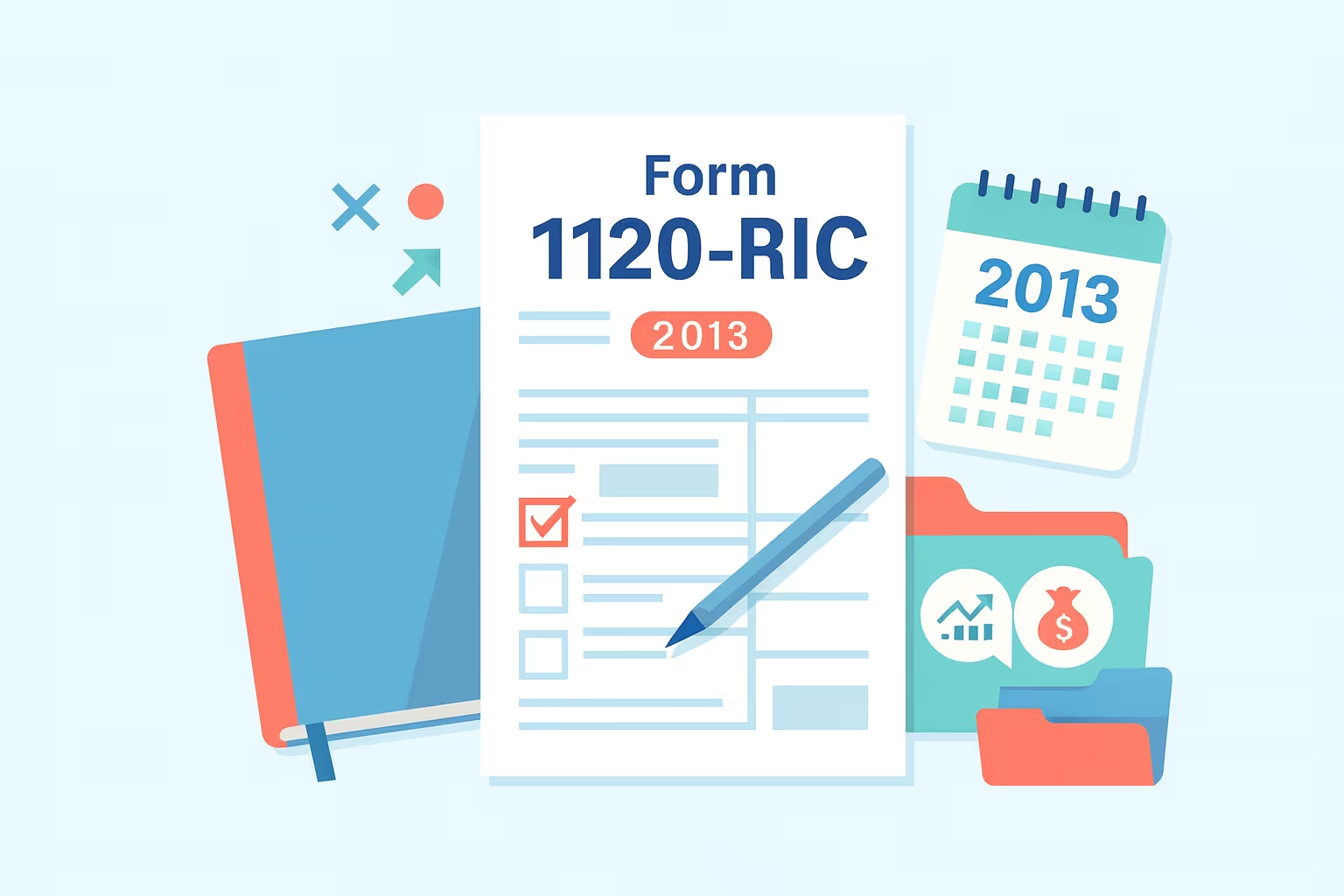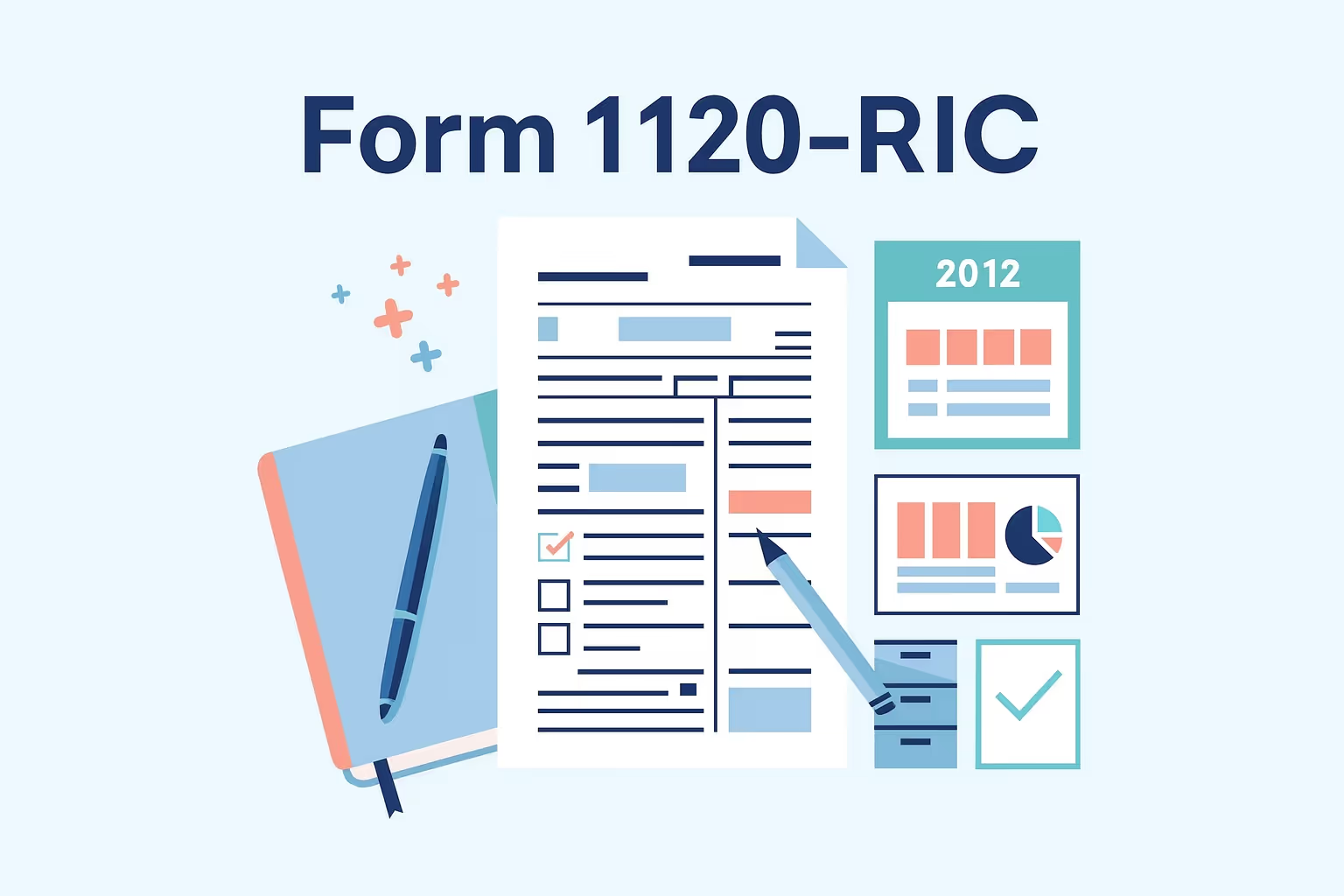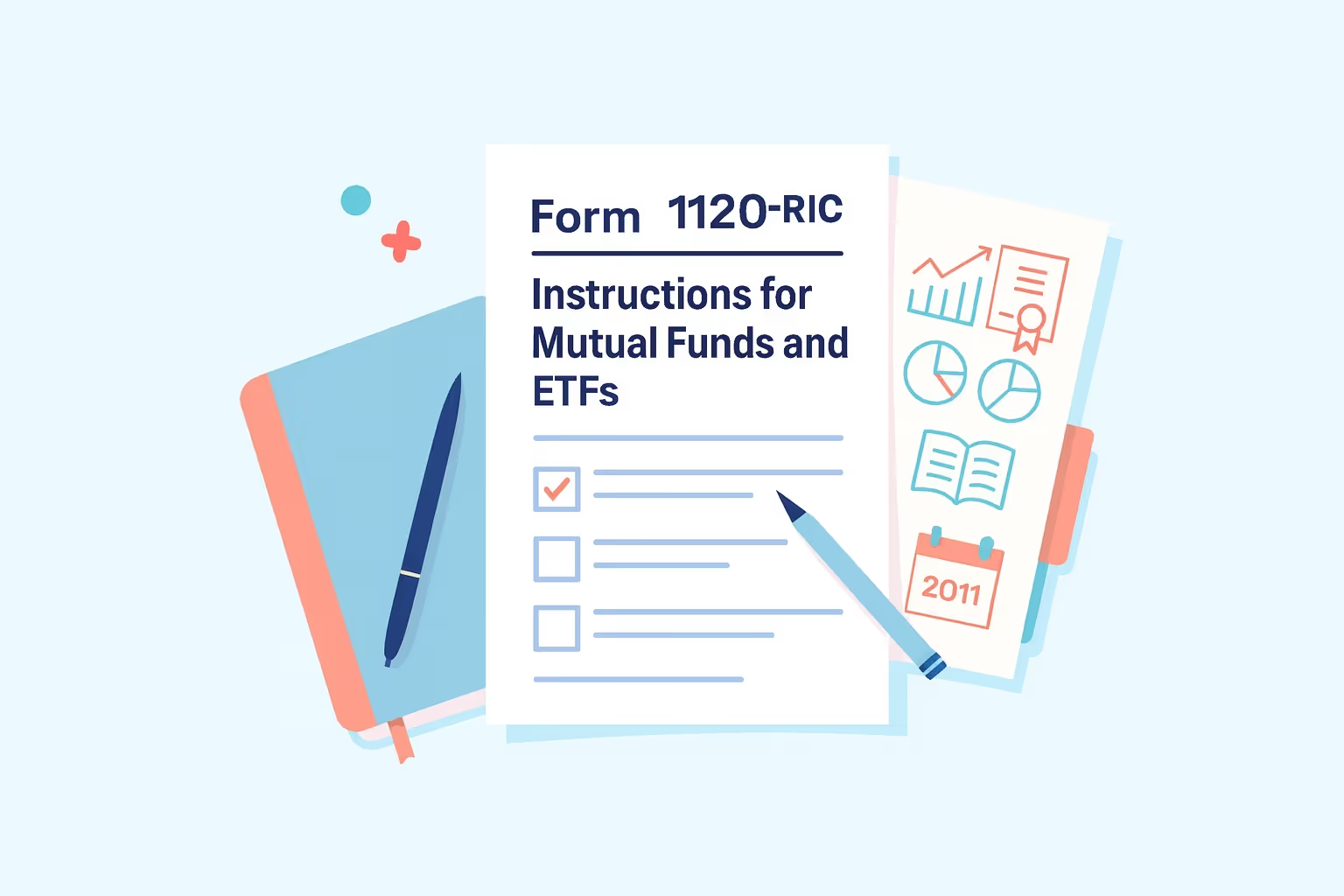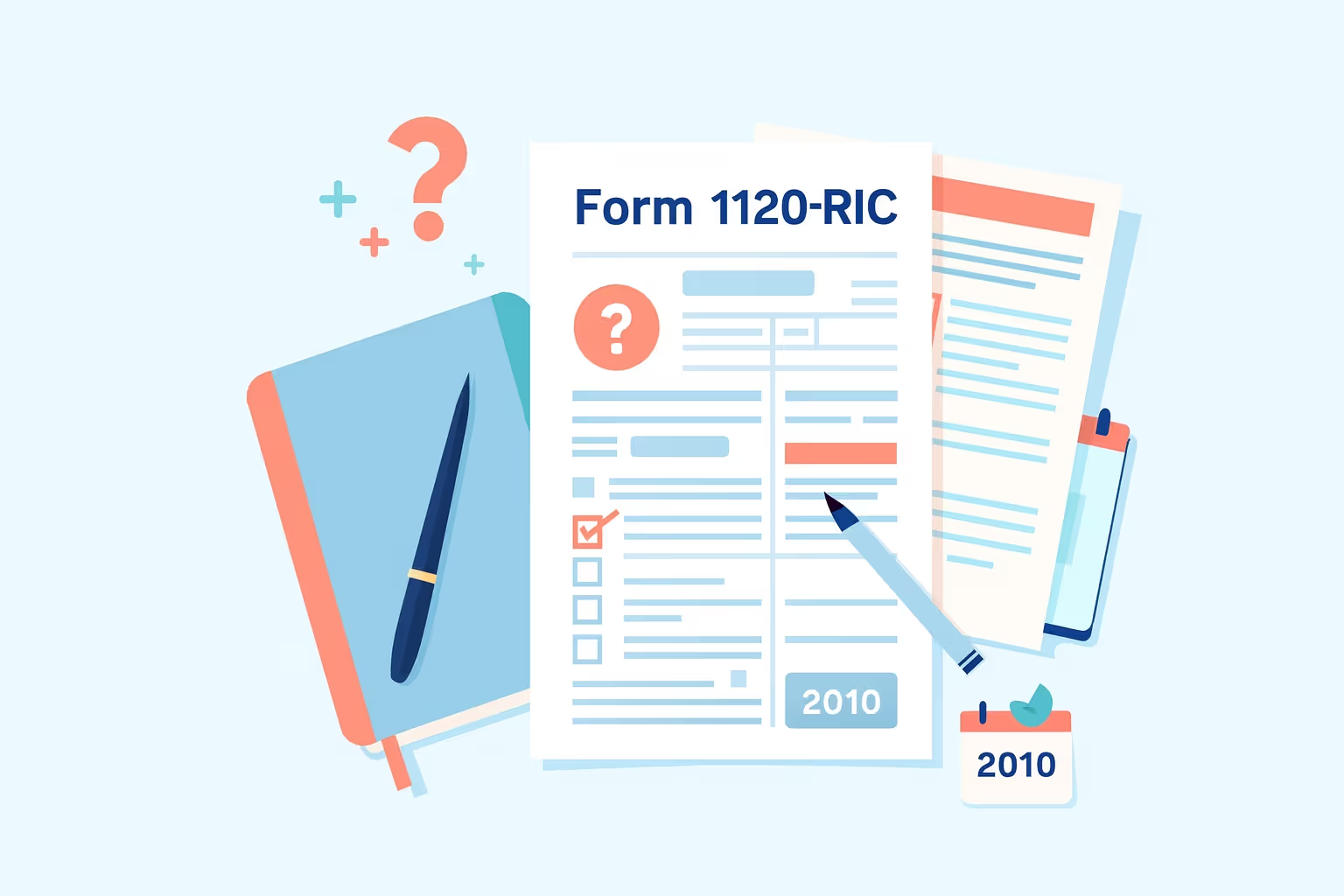Formulario 1120-RIC 2014: instrucciones para fondos mutuos y ETF
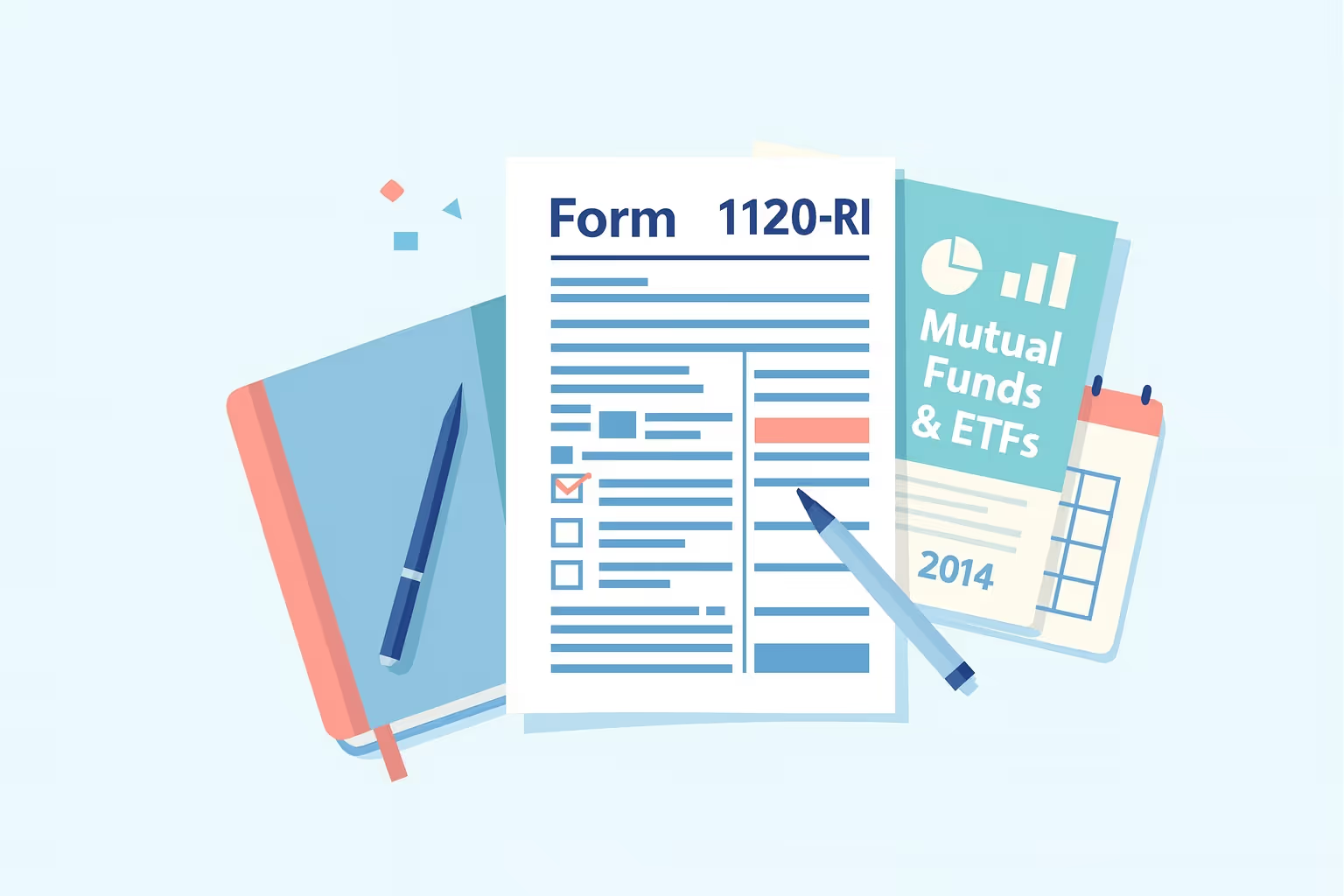
Los fondos mutuos, los fondos cotizados en bolsa y otros fondos de inversión utilizan el formulario 1120-RIC (Declaración de impuestos sobre la renta de los Estados Unidos para sociedades de inversión reguladas) para elegir el tratamiento como sociedades de inversión reguladas en virtud de la sección 851 del Código de Impuestos Internos. Las empresas nacionales utilizan este formulario para declarar los ingresos imponibles, calcular las obligaciones tributarias y mantener una elección válida para obtener la condición de RIC para el año fiscal 2014. Cada declaración debe incluir cifras precisas para cumplir con las regulaciones del Tesoro y del IRS.
Las sociedades de inversión reguladas determinan los ingresos imponibles de las sociedades de inversión declarando las transacciones de dividendos, intereses y valores que afectan a las ganancias del fondo. Al distribuir los ingresos entre los accionistas, estas entidades evitan la doble tributación y mantienen prácticas de presentación de informes transparentes. La divulgación coherente de las ganancias de capital a largo plazo, los activos de los fondos y los valores de distribución refuerza la transparencia para los inversores y respalda las operaciones eficientes desde el punto de vista fiscal. Cada cifra reportada debe coincidir con las transacciones verificadas y los costos documentados de la empresa.
La preparación de una declaración de impuestos de 2014 para las entidades reguladas requiere documentación precisa, cronogramas verificados y un número de identificación del empleador (EIN) exacto. Las empresas deben confirmar que los totales coinciden con sus registros justificativos antes de presentarlos. Para obtener una guía específica sobre la presentación de informes, consulte el archivo Instrucciones del IRS para el formulario 1120-RIC (2014), que describen los pasos para la presentación de informes y el cumplimiento adecuados.
Conceptos básicos de declaración de impuestos sobre la renta y calificación RIC
La presentación de una declaración de impuestos sobre la renta como una sociedad de inversión regulada (RIC) requiere una planificación cuidadosa, informes precisos y el cumplimiento de las regulaciones del Servicio de Impuestos Internos. El formulario 1120-RIC (declaración de impuestos sobre la renta de los Estados Unidos para sociedades de inversión reguladas) está diseñado específicamente para las empresas nacionales que reúnen los requisitos para obtener la calificación de RIC en virtud de la sección 851 del Código de Impuestos Internos. Estas sociedades deben demostrar que sus ganancias, inversiones y distribuciones cumplen con los requisitos legales para las sociedades de inversión reguladas.
Una corporación debe determinar la elegibilidad antes de presentar su declaración de impuestos sobre la renta. El proceso de calificación implica cumplir con los estándares de composición de ingresos, diversificación de activos y distribución. El cumplimiento de estas normas permite a la empresa mantener el tratamiento de transferencia y evitar la doble imposición sobre los ingresos pagados a los accionistas. Si una empresa no cumple con algún requisito, el IRS puede reclasificarla y aplicar la tributación corporativa estándar.
Requisitos básicos de calificación
- Prueba de ingresos del 90%: El RIC debe obtener al menos el 90% de los ingresos imponibles de su sociedad de inversión por dividendos, intereses y transacciones de valores, así como ingresos por inversiones comparables. Esta prueba garantiza que la empresa funcione principalmente como un fondo de inversión, y no como una empresa operativa.
- Prueba de diversificación de activos: Al final de cada trimestre, al menos el 50% de los activos del fondo deben consistir en efectivo, bonos del gobierno y valores de varios emisores. No se puede invertir más del 25% del valor total en un solo emisor, excepto en valores públicos u otros RIC. Este requisito contribuye a la protección de los inversores y a la estabilidad de la cartera.
- Requisito de distribución: El RIC debe distribuir al menos el 90% de sus ingresos imponibles cada año, excluyendo las ganancias netas de capital, a sus accionistas. Estas distribuciones reducen la obligación tributaria de la empresa y garantizan la transparencia para los accionistas. Los inversores que compran acciones se benefician cuando la empresa cumple con este estándar, ya que los ingresos se gravan a nivel de los accionistas y no a nivel corporativo.
- Elección y mantenimiento del estatus de RIC: Las corporaciones nacionales elegibles deben elegir el estatus de RIC en su declaración de impuestos inicial para las entidades de inversión reguladas. Para preservar esta elección, las empresas deben seguir cumpliendo anualmente con los estándares de ingresos, activos y distribución. La revocación puede provocar cambios significativos en las obligaciones tributarias y en el tratamiento contable del impuesto sobre la renta.
Una declaración de impuestos bien preparada para las entidades de inversión reguladas confirma el cumplimiento y garantiza el cálculo adecuado de los ingresos netos, las ganancias y las distribuciones de los accionistas. Mantener la precisión en las pruebas y los cronogramas fomenta la confianza entre los inversores y ayuda a evitar futuros ajustes en la presentación de informes.
Actualizaciones de formularios y cambios en los informes de 2014
El año fiscal 2014 introdujo varias actualizaciones clave que afectan a la forma en que las sociedades de inversión reguladas presentan el formulario 1120-RIC (declaración del impuesto sobre la renta de EE. UU. para sociedades de inversión reguladas). Los fondos mutuos, los fondos cotizados en bolsa y otras entidades reguladas debían ajustar sus procedimientos de cumplimiento para reflejar los nuevos requisitos de presentación de informes. Estas revisiones tenían como objetivo simplificar la precisión de los datos, mejorar la claridad de los cronogramas y alinear los informes de ingresos con una supervisión más amplia del Servicio de Impuestos Internos.
- Direcciones de presentación actualizadas: El IRS reasignó los centros de procesamiento según el total de los activos del fondo y la ubicación geográfica. Las empresas nacionales con activos por debajo de los umbrales específicos recibieron instrucciones de enviar por correo sus declaraciones de impuestos corporativos al Centro de Servicios de Cincinnati, mientras que los fondos de inversión más grandes las presentaron a Ogden, Utah. Estos cambios mejoraron la eficiencia del procesamiento y redujeron los costos administrativos para los declarantes y el Servicio.
- Éntesis en la presentación electrónica: El IRS priorizó la presentación electrónica de los RIC que cumplen con los criterios de elegibilidad. La presentación electrónica proporcionó recibos de confirmación, mejoró la validación de los datos y redujo las tasas de rechazo de las declaraciones en las que faltaban datos. Este enfoque redujo las demoras en la tramitación y ayudó a las empresas a cumplir con los plazos para declarar la renta imponible y cumplir con sus obligaciones tributarias.
- Revisiones del Anexo D: Las modificaciones al Anexo D aclararon la forma en que las empresas declaran las ganancias de capital a corto y largo plazo. Estos ajustes aseguraron una clasificación coherente de las transacciones de valores y un seguimiento preciso de las ganancias. Un diseño y un etiquetado más sencillos ayudaron a los contadores de fondos a gestionar diversas carteras de activos y actividades de negociación.
- Mejoras en los informes de inversión extranjera: Los RIC con participaciones en sociedades extranjeras están obligados a proporcionar información adicional. Las normas de presentación de informes revisadas, alineadas con las normas de transparencia mundiales, respaldaron el cálculo preciso de la renta imponible de las sociedades de inversión. Las entidades que realizan inversiones transfronterizas deben cumplir con las normas de abastecimiento y conversión de divisas.
- Estándares de diversificación de activos aclarados: El IRS amplió las definiciones que cubren los valores elegibles y los bonos del gobierno incluidos en las pruebas de diversificación. Estas mejoras permitieron a los administradores de fondos mantener el cumplimiento y verificar el valor de la cartera cada trimestre. La aplicación coherente de estas actualizaciones reforzó la preparación para la auditoría y la confianza de los inversores.
En conjunto, las actualizaciones de 2014 mejoraron la precisión, la coherencia y la confianza de los inversores en las presentaciones del RIC. Comprender estos cambios ayuda a las entidades reguladas a mantener el cumplimiento, salvaguardar el estatus de RIC e informar cifras que reflejen el rendimiento real de los fondos.
Instrucciones de presentación paso a paso del formulario 1120-RIC (declaración de impuestos sobre la renta de EE. UU. para sociedades de inversión reguladas)
La presentación del formulario 1120-RIC requiere precisión, documentación organizada y atención a las actualizaciones del año tributario 2014. Los fondos mutuos, los fondos cotizados en bolsa y otras entidades reguladas deben alinear cada entrada con registros verificados de ganancias, valores y distribuciones a los accionistas para garantizar la presentación adecuada de los ingresos imponibles y las obligaciones tributarias.
Paso 1: Reunir los detalles de identificación de la empresa
Recopile el nombre legal, la dirección y el número de identificación del empleador (EIN) de la empresa. Verifique la clasificación como sociedad de inversión regulada según la sección 851 y confirme que las nuevas sociedades han documentado su elección de RIC. Compare los detalles con los certificados organizativos, las declaraciones anteriores y los registros bancarios, e incluya las fechas correctas del período de presentación de informes.
Paso 2: Complete la sección de encabezados
Complete la fecha de finalización del año tributario, la dirección completa de la empresa y el EIN en la primera página. Registre las modificaciones o cambios en el nombre o la dirección e informe los activos totales del balance. Marque las casillas de verificación para las declaraciones finales o modificadas y verifique todas las entradas antes de continuar.
Paso 3: Reportar los ingresos por inversiones
Introduzca todas las fuentes de ingresos, incluidos los dividendos, los intereses y las ganancias de la venta de valores. Clasifique las transacciones con precisión como ganancias a largo o corto plazo e incluya los intereses de los instrumentos de deuda. Excluya los ingresos exentos de impuestos de los totales imponibles, pero indíquelos cuando sea necesario, aplicando los tipos de cambio aprobados para las participaciones en el extranjero.
Paso 4: Calcular las deducciones permitidas
Enumere las deducciones que califican, como los salarios, los intereses, el alquiler, los honorarios profesionales y la depreciación. Incluya los gastos directamente relacionados con la administración de la cartera, el servicio a los accionistas y la generación de ingresos. Respalde cada entrada con recibos o estados de cuenta y concilie las cifras con el libro mayor para garantizar su precisión.
Paso 5: Complete el Anexo A: Deducción de dividendos pagados
Informe las distribuciones a los accionistas, incluidas las declaradas en el último trimestre pero pagadas en enero. Distinga entre dividendos ordinarios, dividendos por ganancias de capital y dividendos consensuados. Respalde cada pago con resoluciones de la junta directiva o actas de las reuniones que autoricen la distribución. La deducción reduce los ingresos imponibles y preserva el tratamiento de transferencia.
Paso 6: Complete el Anexo J: Cálculo de impuestos y créditos
Calcule la obligación tributaria total utilizando las tasas legales, las ganancias no distribuidas y los créditos fiscales aplicables. Concilie los pagos estimados y los remanentes del año anterior con las cifras actuales. Confirme la precisión adjuntando cronogramas que respalden cada cálculo.
Paso 7: Incluya cronogramas adicionales y formularios de respaldo
Adjunte el Anexo D para las ganancias de capital y todos los formularios complementarios requeridos, incluidos el formulario 2439, el formulario 4797 y el formulario 4562. Etiquete cada uno con el EIN y el año tributario. Reúna los documentos en el orden prescrito por el IRS y confirme la coherencia de todas las cifras.
Paso 8: Revisa todas las cifras y totales
Verifique los totales, las deducciones y los subtotales para confirmar la precisión matemática. Concilie los montos declarados con los registros contables para garantizar la alineación. Confirme que los ingresos imponibles coincidan con las distribuciones de los accionistas que figuran en el Anexo A.
Paso 9: Firmar y presentar la declaración
Un oficial autorizado debe firmar y fechar la declaración e incluir los datos de contacto. Preséntela electrónicamente o por correo, según la elegibilidad, y conserve el comprobante de presentación. Guarde una copia completa de la declaración presentada y toda la documentación de respaldo en los registros permanentes de la compañía.
Completar el formulario 1120-RIC requiere diligencia, documentación exhaustiva y el cumplimiento de las normas del Tesoro y el IRS. Cada paso garantiza la presentación precisa de informes sobre los activos, los ingresos y las distribuciones del año tributario 2014. Revise lo archivado Formulario 1120-RIC del IRS (2014) para el diseño oficial, los cronogramas y las referencias de línea utilizados durante ese período de presentación.
Métodos de presentación de fondos cotizados en bolsa y fondos mutuos
Los fondos mutuos y los fondos cotizados en bolsa que califican como sociedades de inversión reguladas deben seleccionar un método de presentación adecuado para su formulario 1120-RIC. El enfoque elegido, ya sea electrónico o en papel, determina cómo el Servicio de Impuestos Internos recibe, procesa y reconoce la declaración del impuesto sobre la renta corporativa. Cada opción conlleva requisitos únicos que afectan a la eficiencia, el costo y la supervisión administrativa.
La presentación electrónica proporciona una forma segura y eficiente para que las empresas nacionales transmitan datos directamente al IRS. Muchos fondos de inversión prefieren este método porque reduce los errores de transcripción y confirma la recepción de inmediato. También acelera el tiempo de procesamiento al tiempo que integra comprobaciones automáticas para garantizar la precisión aritmética y la validación de los números de identificación del empleador.
La presentación en papel sigue siendo una opción aceptable para las empresas que no cumplen con los requisitos de elegibilidad para la presentación electrónica o prefieren los métodos de presentación tradicionales. Envíe estas declaraciones por correo al Centro de Servicio del IRS designado según los activos y la dirección comercial del fondo. Las empresas deben conservar un comprobante de envío enviado por correo certificado o por transportistas privados aprobados.
Consideraciones y opciones de presentación
- La presentación electrónica garantiza una confirmación inmediata, evaluaciones más rápidas y menos errores administrativos para las empresas que gestionan transacciones de valores complejas.
- Los declarantes en papel deben reunir todos los anexos, formularios y archivos adjuntos en el orden correcto y confirmar la exactitud de la dirección antes de enviar la declaración por correo.
- Las compañías de inversión reguladas pueden presentar los pagos electrónicamente a través del Sistema electrónico de pago de impuestos federales (EFTPS) o incluir un cheque en las declaraciones en papel.
- Los pagos de impuestos deben coincidir con el monto calculado en la declaración y reflejar la obligación tributaria total de la compañía durante el período de presentación.
- Las empresas deben guardar copias completas de cada formulario, declaración de dividendos y cronograma de ganancias de capital en un almacenamiento digital o físico seguro.
- El mantenimiento de registros durante al menos tres años respalda las revisiones de cumplimiento y refuerza la preparación para posibles auditorías.
La elección entre la presentación electrónica y la presentación en papel depende de la infraestructura, los recursos y la complejidad de los informes del fondo. Ambos métodos requieren cifras verificadas, documentación coherente y una finalización puntual. Una preparación cuidadosa y un mantenimiento minucioso de los registros refuerzan la precisión y respaldan la confianza de los inversores en cada ciclo de presentación de informes.
Declaración de ganancias de capital, bonos y distribuciones
La presentación precisa de informes sobre las ganancias de capital, las transacciones de valores y las distribuciones de los accionistas es esencial para mantener el cumplimiento de los requisitos del Servicio de Impuestos Internos. Las sociedades de inversión reguladas deben presentar cálculos precisos de los ingresos imponibles y los ingresos imponibles de las sociedades de inversión para preservar el tratamiento de transferencia. Cada uno de los pasos siguientes describe cómo los fondos mutuos y los fondos cotizados en bolsa deben registrar las ganancias de capital, los intereses de los bonos y las distribuciones de dividendos con arreglo a las directrices de 2014.
1. Clasifique todas las ganancias y pérdidas de capital
Identifique cada transacción que involucre ventas, reembolsos o intercambios de valores. Separe las ganancias en categorías de ganancias de capital a corto y largo plazo para garantizar una clasificación adecuada en el Anexo D. Verifique cada cifra comparándola con las confirmaciones comerciales, los estados de corretaje y los registros contables de los fondos para reflejar las ganancias de manera precisa.
2. Incluya los ingresos por intereses de los bonos
Registre todos los intereses devengados por bonos corporativos, valores del Tesoro de los Estados Unidos y otras obligaciones gubernamentales durante el año tributario. Excluya los intereses exentos de impuestos de los totales imponibles, pero hágalos saber al declarar los ingresos imponibles de las sociedades de inversión. La documentación adecuada de los intereses de los bonos ayuda a determinar los ingresos totales sujetos a impuestos corporativos.
3. Asigne distribuciones a los accionistas
Determine el monto de las distribuciones de ingresos ordinarios y ganancias de capital pagadas a los accionistas. Confirme que todos los montos declarados se ajusten a las resoluciones de la junta y las fechas de pago. Las distribuciones oportunas permiten a los inversores que compran acciones recibir información precisa sobre los dividendos para fines de declaración de impuestos individuales.
4. Aplique las reglas de dividendos por derrame y deficiencia
Indique los dividendos declarados en el último trimestre pero pagados en enero como parte de los ingresos del año anterior. Identifique cualquier dividendo deficitario emitido para corregir las subdistribuciones de períodos anteriores. Mantenga cronogramas que documenten las fechas de pago y las asignaciones a los accionistas para cada ciclo de presentación de informes.
5. Prepare el formulario 2439 para ganancias de capital no distribuidas
Utilice Formulario 2439 del IRS (2014) cuando la empresa retiene las ganancias de capital en lugar de distribuirlas. Proporcione a los accionistas el formulario completo para que puedan declarar las ganancias en sus declaraciones individuales. Asegúrese de que todos los montos retenidos se reflejen en el cálculo de la obligación tributaria total de la empresa.
La presentación precisa de informes sobre las ganancias de capital, los intereses y las distribuciones garantiza la transparencia y el cumplimiento de las regulaciones pertinentes. Cada cronograma completado correctamente verifica las fuentes de ingresos, protege el estatus del RIC y respalda la confianza de los inversores en las operaciones de los fondos.
Cronogramas requeridos, otros formularios y errores comunes
Las sociedades de inversión reguladas que presenten el formulario 1120-RIC deben incluir anexos específicos y formularios de respaldo que demuestren el cumplimiento de las normas de presentación de informes del Servicio de Impuestos Internos. Cada anexo tiene un propósito definido dentro de la declaración de impuestos sobre la renta de la corporación. Los documentos faltantes o incompletos pueden retrasar el procesamiento, aumentar la correspondencia o afectar la precisión de los cálculos de la renta imponible.
Cronogramas principales
- El Anexo A informa los dividendos totales pagados a los accionistas, incluidos los dividendos ordinarios, las distribuciones de ganancias de capital y los dividendos por consentimiento. La presentación de informes precisos garantiza una deducción adecuada y reduce la doble imposición.
- El Anexo B proporciona detalles sobre los ingresos exentos de impuestos, incluidos los intereses devengados por bonos municipales y otros valores exentos. Cada entrada debe coincidir con la base imponible verificada de la sociedad de inversión.
- El anexo D registra todas las ganancias de capital a corto y largo plazo de las transacciones de valores. La documentación de respaldo debe confirmar las fechas de negociación, los ingresos y la base de costos de cada venta.
- El Anexo J calcula la obligación tributaria total, aplica los créditos permitidos y concilia los pagos realizados durante el año tributario.
- El Anexo K captura otra información esencial, incluidos los métodos de contabilidad, los detalles de los accionistas y las divulgaciones requeridas para cumplir con las normas de presentación de informes.
- El anexo L presenta las posiciones de activos, pasivos y acciones del fondo en función de los valores contables al principio y al final del año fiscal.
- El anexo M-1 concilia los ingresos contables con los ingresos imponibles, identificando los ajustes que afectan el reconocimiento de los ingresos netos.
- El anexo M-2 registra los cambios en las ganancias retenidas y refleja las distribuciones, los ajustes y los saldos de cierre.
Formularios de apoyo
- El formulario 2438 informa sobre las ganancias de capital no distribuidas gravadas a nivel corporativo antes de la asignación de accionistas.
- El formulario 4562 cubre la depreciación y amortización de equipos o activos intangibles mantenidos por el fondo.
- El formulario 4797 registra la venta o el intercambio de propiedades comerciales, como bienes inmuebles o activos depreciables.
- El formulario 5472 revela las transacciones declarables con sociedades extranjeras o partes relacionadas.
- El formulario 8281 identifica los instrumentos de descuento de emisión original ofrecidos públicamente, cuando corresponda.
Errores comunes
- Omitir los cronogramas requeridos o enviar archivos adjuntos incompletos puede provocar demoras en el procesamiento del IRS y en la correspondencia adicional.
- La inexactitud de las cifras de dividendos, ingresos imponibles o ganancias de capital da como resultado cálculos imprecisos de los impuestos.
- No verificar el número de identificación del empleador o el año tributario en cada página provoca desajustes administrativos.
- Omitir las divulgaciones requeridas o los cronogramas de conciliación crea inconsistencias entre los registros contables e impositivos.
Una revisión exhaustiva de los cronogramas y los anexos garantiza que la declaración refleje cifras precisas y el cumplimiento de todos los requisitos. Completar cada formulario con precisión contribuye a la transparencia y reduce la necesidad de correcciones futuras.
Información adicional para quienes declaran sin actividad y por primera vez
Las sociedades de inversión reguladas con poca o ninguna actividad operativa durante el año fiscal aún deben completar el formulario 1120-RIC de EE. UU. para cumplir con los requisitos del Servicio de Impuestos Internos. La presentación de la declaración verifica que la empresa haya elegido la calificación de RIC activa en virtud de la Sección 851 y preserva la elegibilidad para presentar informes de manera eficiente desde el punto de vista fiscal. Incluso sin ingresos, distribuciones o ganancias de capital sustanciales, la presentación precisa de la declaración garantiza un reconocimiento adecuado de la continuidad corporativa.
Descripción general de la presentación de archivos sin actividad
Se aplica una declaración de actividad cero cuando una empresa no informa de ingresos por inversiones o distribuciones de accionistas significativos. El fondo puede seguir manteniendo activos limitados, como bonos, efectivo o valores a corto plazo, e incurrir en gastos menores por concepto de servicios contables o administrativos. Obtener una declaración completa, incluso con cifras mínimas, demuestra la intención de la entidad de operar como una sociedad de inversión regulada y mantener la elegibilidad para recibir un tratamiento fiscal favorable.
Requisitos de presentación para entidades inactivas
Las empresas deben ingresar su número de identificación del empleador, el cierre del año fiscal y la información completa de la dirección. Cada línea de ingresos, deducciones y activos debe contener un valor, incluso si es cero. La declaración debe ir acompañada de los cronogramas obligatorios, como los balances generales, los estados de conciliación y los resúmenes de las ganancias retenidas. La presentación de informes sobre los gastos ordinarios, incluidos los cargos legales o de cumplimiento, proporciona un panorama financiero completo del año sobre el que se informa.
Guía para quienes declaran por primera vez
Los RIC recién establecidos deben verificar el cumplimiento de las pruebas de ingresos, activos y distribución antes de presentar su declaración de impuestos inicial. La adopción temprana de prácticas de contabilidad estructurada permite un seguimiento preciso de los activos, los ingresos imponibles y las distribuciones a los accionistas del fondo.
La presentación correcta de una declaración sin actividad o del primer año refuerza el cumplimiento y la preparación para ampliar las operaciones. La presentación de informes coherentes aumenta la credibilidad ante los reguladores y respalda la confianza de los inversores en las futuras presentaciones.
Preguntas frecuentes
¿Qué son las sociedades de inversión reguladas y en qué se diferencian de otras entidades?
Las sociedades de inversión reguladas eligen el tratamiento en virtud de la Sección 851 del Código de Impuestos Internos. Califican para la tributación transferida si cumplen con los requisitos de ingresos, activos y distribución. Estas entidades se centran en generar ingresos a partir de valores e intereses en lugar de operar una operación o negocio. A diferencia de los fondos mutuos, presentan un formulario 1120-RIC del IRS específico para garantizar que los ingresos imponibles se transfieran a los accionistas y evitar la doble tributación a nivel corporativo.
¿En qué se diferencian los fideicomisos de inversión inmobiliaria de las sociedades de inversión reguladas?
Los fideicomisos de inversión inmobiliaria (REIT) y las sociedades de inversión reguladas comparten similitudes, pero sus fuentes de ingresos son diferentes. Los REIT invierten principalmente en propiedades generadoras de ingresos y valores hipotecarios, mientras que los RIC se centran en acciones, bonos y otros instrumentos financieros. Ambas entidades deben distribuir la mayoría de las ganancias a los accionistas. La rentabilidad de un REIT depende del rendimiento inmobiliario, mientras que los resultados de un RIC reflejan la actividad del mercado y la diversificación de activos entre varios valores.
¿Puede una corporación S o una sociedad de cartera personal calificar como una sociedad de inversión regulada?
Una corporación S o una sociedad de cartera personal no puede optar por declararse como sociedad de inversión regulada. Las sociedades anónimas tipo S transfieren las ganancias directamente a los accionistas sin pagar el impuesto federal sobre la renta a nivel de entidad. Las sociedades de cartera personales, por su parte, se enfrentan a normas tributarias específicas sobre los ingresos pasivos retenidos. Solo las empresas nacionales que cumplan con los criterios de elegibilidad del RIC, incluidos los estándares de diversificación de activos y composición de ingresos, pueden reunir los requisitos para presentar el formulario 1120-RIC del IRS.
¿Cómo deben los fondos declarar los activos totales al completar el formulario 1120-RIC?
Los fondos deben declarar los activos totales tanto al principio como al final del año tributario para reflejar los valores exactos del balance. La cifra debe incluir valores, efectivo y cuentas por cobrar a su valor justo de mercado. La presentación de informes precisos garantiza el cumplimiento de las pruebas de diversificación de activos y respalda la verificación de los cálculos de la renta imponible. Cada importe debe conciliarse con los registros y estados contables utilizados para preparar la declaración, garantizando la transparencia financiera.
¿Cómo se tratan las acciones de ETF para las sociedades de inversión reguladas?
Los fondos cotizados en bolsa (ETF) están estructurados como sociedades de inversión reguladas que siguen las mismas normas de información que los fondos mutuos. Las acciones de los ETF representan la propiedad de una cartera de valores diseñada para rastrear un índice bursátil específico. Cada fondo debe declarar los ingresos, las distribuciones y las ganancias de capital en el formulario 1120-RIC del IRS. Los inversores compran y venden acciones de ETF en bolsas, de forma similar a las acciones ordinarias, y cada transacción refleja los cambios en el valor y la composición de los activos del fondo.
¿Pueden las sociedades de inversión reguladas invertir en gas natural o en activos relacionados con la energía?
Las sociedades de inversión reguladas pueden incluir productores de gas natural, operadores de gasoductos o valores del sector energético dentro de sus carteras diversificadas. Estas inversiones deben cumplir con las pruebas de diversificación de activos e ingresos descritas en la sección 851 del Código de Impuestos Internos. El fondo debe medir dichas participaciones a su valor de mercado y clasificarlas como valores calificados cuando corresponda. La exposición relacionada con la energía puede agregar beneficios de diversificación, siempre que la empresa mantenga el cumplimiento de los requisitos federales para las entidades de inversión reguladas.
¿Qué sucede cuando los inversores compran acciones adicionales durante el año fiscal?
Cuando los inversores compran acciones adicionales, la base de capital y los activos totales de la empresa aumentan. Los fondos adicionales pueden respaldar oportunidades de inversión más amplias en acciones, bonos o instrumentos a corto plazo. Cada nueva emisión debe respetar los intereses de los accionistas actuales y alinearse con la estrategia de inversión del fondo. El seguimiento preciso de la actividad de las acciones garantiza la asignación adecuada de los ingresos, las ganancias de capital y la distribución de dividendos, tal como se indica en el formulario 1120-RIC anual del IRS.
















